Mosquito Bites and Shared Itch
There is no escaping the mosquitoes, even in the cool and misty cloud forest. Certainly in comparison to lower elevation, the density of mosquitoes at the Nectandra Reserve is low, and thankfully, does not include either Aedes aegypti or albopictus, the fearsome vectors of several human pathogens (yellow fever, dengue, chikungunya and Zika etc). But disease carriers or no, mosquito bites are infernally itchy.
Both male and female mosquitoes feed on sugary liquids (nectar, aphid honeydew, fruit juices etc), but only female mosquitoes suck blood to obtain protein for their eggs. We have all experienced that pin prick sensation when she inserts her long, slender and stiff proboscis through our skin. Below are photos (Fig 1) of the proboscis before and after removal of the opaque outer cuticle. The mosquito was being prepared for a synchrotron X-ray imaging technique to study the dynamics of blood suction in vivo. The bared proboscis in Fig. 1B is actually a bundle of six stylets — one pair to hold on to the victim’s skin, another pair with saw teeth to cut through it, the fifth is a probe for the victim’s blood vessels and the last, a straw-like suction tube which is the actual food canal.
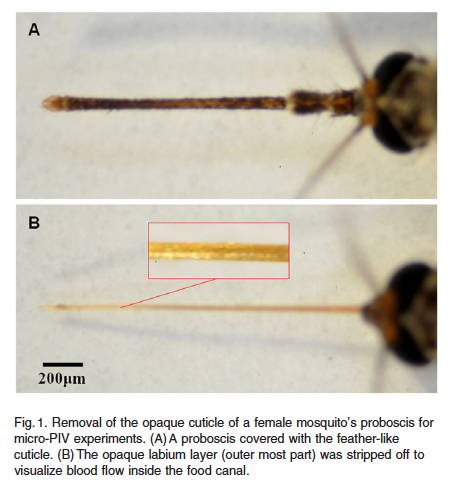
With the proboscis in position, she injects 1 µL of a potent mix of salivary anophelin proteins (sometime comingled with pathogens) to numb the pain of the bite and thin the host’s blood for easier suctioning. Incidentally, the itch receptors are only found in the top two layers of human skin. Surgical removal of those skin layers removes the capacity to itch! That explains why we do not feel the itch in the muscles.
To pump blood the mosquito does not use her heart, an organ dedicated to her circulatory system. Instead, blood suction is accomplished through a different pump mechanism located in her tiny head. It consists of two interconnected but separate pumps .
Below is a series of micrographs showing the travel of an opaque iodine solution (to simulate blood) through the food canal and through the first smaller pump (CP) and second larger pump (PP) in the Fig 2.
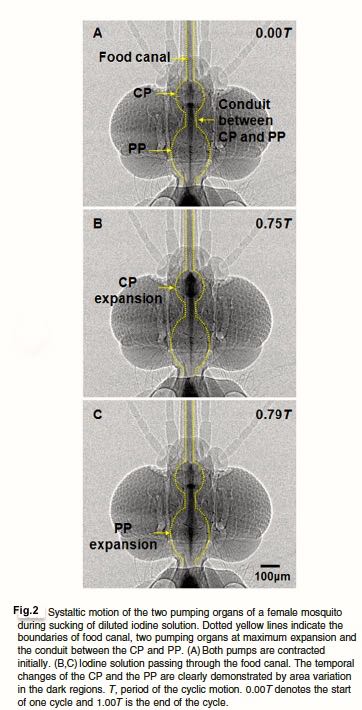
Why two pumps and not just one? Turns out the anatomy of the mosquito head requires the blood to course through a sharp 120º bend and a check valve (C-P, Fig. 3 ) to reach the gut. The first smaller pump CP is just efficient enough to get the viscous blood through the bend and valve. The large pump PP, already inflated and ready, then propels it trough the digestive system . The two pumps in series are superbly optimized for the task.
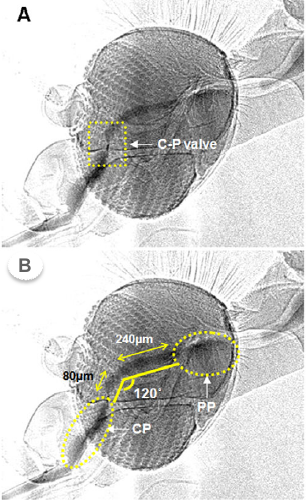
For a spectacular and more graphic video of the mosquito in action, click on WATCH: Mosquitoes use 6 needles to suck your blood
The impetus for this blog was triggered by a startling observation on a nightwalk at Nectandra not too long ago. My hiking companion spotted a Pug-nosed Anole lizard (Anolis capito) perched on a branch. She took the photo below of this fairly common diurnal species in our forest. The 5 in. lizard (torso only) almost always rests aligned with the tree branch or trunk, with its legs retracted close to its body. Its green speckled marking is often hard to spot during the day because of its excellent camouflage.
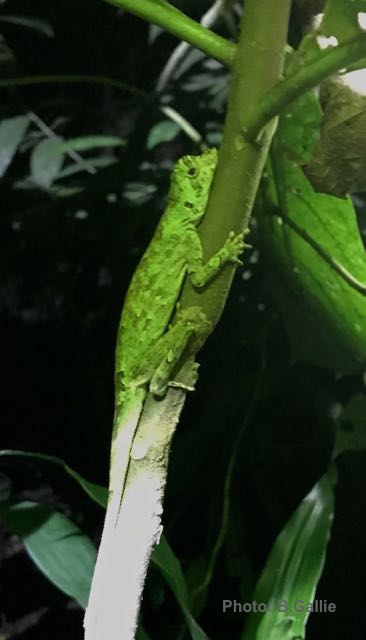
I, too, lined up to take a shot while my companion aimed her flash light to provide me with extra light. I zoomed in with my macro-lens. To my utter astonishment, the lizard was not alone! I spotted four tiny mosquitoes on the lizard, two on the upper torso and two near the tail .
Magnified 5X on the computer screen, the photo was even more telling. The mosquitoes must have been feasting for quite some time. They all appeared to be fully engorged but obviously unsatisfied and still feeding. Their stomachs are filled with hemolymph and quite extended. Full engorgement takes about 3 -10 minutes. Meanwhile, the immobile lizard looked oblivious, or perhaps just resigned.
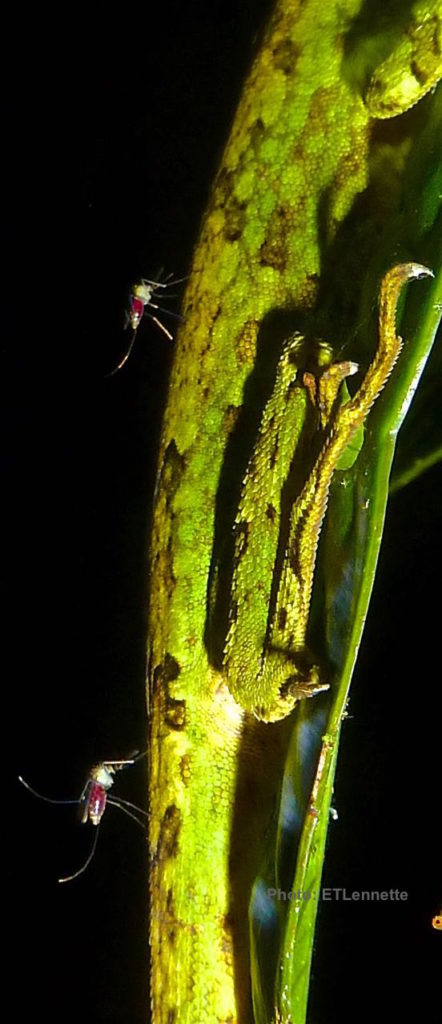
There are more than 3000 species of mosquitoes worldwide. They feed on a wide range of hosts — mammals, birds, reptiles, amphibians and fish. Their feeding patterns can be broadly classified into: a) specialists that feed exclusively on warm-blooded animals or cold-blooded animals but not both, b) generalists that feed on both, and c) opportunists that feed on varying available hosts depending on geography and climate.
Take the one infamous mosquito genus Aedes on which we have the most information. Two species within the genus, aegypti, once found only in African tropics, and albopictus from southeast Asia, have now spread to all five continents, even to temperate regions. They have different ecologic niches, biting habits, and host preferences. Aegypti feed mostly on humans, but sometimes cattle, pigs, cat, rat and chicken. Albopictus, on the other hand, feed exclusively on humans. Because of their preference in biting humans, they are in effect transferring the pathogens from an infected human to a susceptible human. Together, they contribute to half million human deaths annually from the four diseases mentioned above.
Things are quite a bit more complicated in Eastern equine encephalomyelitis, a rare mosquito-borne viral infection in horses and humans that is often fatal due to brain inflammation. Here several genera of mosquito are involved as “bridge” vectors. They transfer the pathogen from the sources that are mainly birds, but also reptiles and amphibians — to susceptible humans and horses. There are no human-to-human transmissions.
From just the little we know of mosquitoes as major vectors of human diseases, it is not hard to extrapolate the power of the flying hypodermic needles to mix pathogens and match hosts, probably including our Pug-nose lizard.
Aside: I couldn’t help feel a sympathetic itch looking at my photo of the lizard, and was curious to know if amphibians and reptiles itch from mosquito bites. My literature search yielded only one Australian observation describing bitten frogs in the wild, mostly on eyelids, do not get irritated by the mosquitoes bites. However, they do end up with inflamed swelling on the eyelids.
Click here to unsuscribe